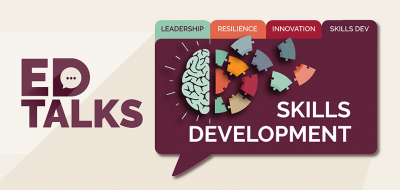Mental Health in the Workplace – Practical ways for organisations and employees to create an ecosystem in which mental health and wellness can flourish.
By Daniëlle Malan, HPCSA Registered Industrial & Organisational Psychologist and SBS-ED faculty member: Managing Mental Health and Wellness at Work
The once-taboo topic of mental health in the workplace is making headway – and with good reason. 1An estimated 12 billion working days are lost globally each year to depression and anxiety at the cost of $1 trillion per year in productivity. What’s even more concerning is that this number is on the rise.
3About one-third of human life is spent working. It is now more than ever needed for an organisation to take a proactive approach to address mental health and wellness in the workplace. Employers and employees cannot afford to bury their heads in the sand.
So, what constitutes good mental health exactly? According to the 2World Health Organization (WHO): “Mental health is a state of mental well-being that enables people to cope with the stresses of life, realise their abilities, learn well and work well, and to contribute to their communities. Mental health conditions occur irrespective of whether work has causally contributed to them.” Thus, the onus lies on both the organisation and the employee to take responsibility to create and have a mentally healthy workplace.
Here are 5 steps that organisations can take to create and maintain a mentally healthy workplace:
- Educate and Introspect
- Before mental health in the workplace can be advocated for, it must be understood and taken seriously. Employers need to understand what mental health entails and how organisational practices can contribute to mental health and well-being.
- Employers can reflect on the impact of their leadership style, people management skills, and the health behaviours they are modelling and how these feed into the organisation’s culture.
- Insights gained through understanding proactive mental health programmes can be an investment that yields valuable returns11.
- 4Prevent
- Mental health conditions can be prevented by managing psychosocial risks in the workplace. These risks include stress, fatigue, bullying, aggression, and violence which can be attributed to job demands, low job control, lack of role clarity, traumatic events and inadequate reward and recognition.
- Psychosocial risks can be mitigated by implementing organisational interventions aimed at reshaping conditions, cultures, and relationships. Examples of such interventions include providing flexible working conditions, implementing frameworks and policies to deal with discrimination and harassment and appointing mental health ambassadors at work and breaking stigma.
- Enable a level of control. Giving employees a sense of autonomy and control at work contributes to job satisfaction and fulfilment, which are likely to aid in preventing poor mental health conditions.
- 5Protect and Promote
- The 6WHO suggests protecting mental health by training managers on recognising and responding to employees experiencing emotional distress and building interpersonal skills (such as how to communicate and listen in better ways).
- 7Support
- Employers can support employees by providing reasonable accommodation, implementing return-to-work programmes after being off-sick and supporting employee initiatives.
- Initiatives and interventions should be monitored and adapted to ensure effectiveness.
- Communicate and Build connections.
- Employers should aim to openly communicate about mental health8 (which can include personal experiences)9, to aid employees to feel safe and engage in open conversations. This can help employers and managers to detect distress and direct employees to available support.
- Make time to connect and have fun as a team.
And here are 3 ways that employees can maintain good mental health and well-being at work:
- 10Employees should take ownership of their mental health.
- Employees contribute equally to creating mentally healthy organisations. It is an employee’s responsibility to report hazards and risk factors to manage psychosocial risks.
- A major part of an employee’s day is spent at work, but employees can still choose how they spend their time outside work. Employees should take time to prioritize their well-being by including the following practices:
- Daily self-care includes being physically active, maintaining a healthy diet, getting adequate sleep, and connecting with friends and family.
- Practice mindfulness and gratitude
- Educating themselves about mental health.
- 11Get involved
Employees represent the largest group within an organisation, and therefore have a significant impact on organisational culture.- Employees should reflect on how their actions feed into the organisation’s culture, for example: ‘How do I treat others? Do I make time to listen to colleagues? Am I openly talking about mental health? Am I adding to a colleague’s workload by not pulling my weight?’
- Enquire and get training on how to become a mental health ambassador.
- Employees can also encourage employers to focus on and offer mental health support and wellness initiatives.
- 12Utilize the resources available.
Many initiatives can be put in place; however, it remains the employee’s responsibility to use or direct their colleagues to these when needed. As well, as to help employers identify support or resources that are needed or insufficient.
Arguably, mental health needs to be taken seriously by employers and employees.

References
1,2 World Health Organization (WHO). 2022. Fact Sheets: Mental health in the workplace, updated September 2022 (online).
3 Naber. (n.d.). One third of your life is spent at work – Gettysburg College. One Third of Your Life Is Spent at Work – Gettysburg College. Retrieved October 7, 2022, from https://www.gettysburg.edu/news/stories?id=79db7b34-630c-4f49-ad32-4ab9ea48e72b
4, 5, 6, 7 World Health Organization (WHO). 2022. Policy Brief: Mental health at work (in press).
8 Heads Up. Creating a mentally healthy workplace: A guide for business leaders and managers. Retrieved October 7,2022, from https://www.headsup.org.au/docs/default-source/resources/bl1256-booklet—creating-a-mentally-healthy-workplace.pdf?sfvrsn=4
9 Greenwood, K. & Krol, N. (2020). 8 Ways managers can support employees’ mental health. Harvard Buisness Review (online).
10 Government of the Western Australia Department of Mines, Industry Regulation and Safety. What can you do to look after your mental health at work? Retrieved October 7, 2022 from http://www.dmp.wa.gov.au/Safety/Your-mental-health-at-work-25130.aspx
11 Deloitte Insights: The ROI in workplace mental health programs: Good for people, good for business. A blueprint for workplace mental health programs (online).
written by





